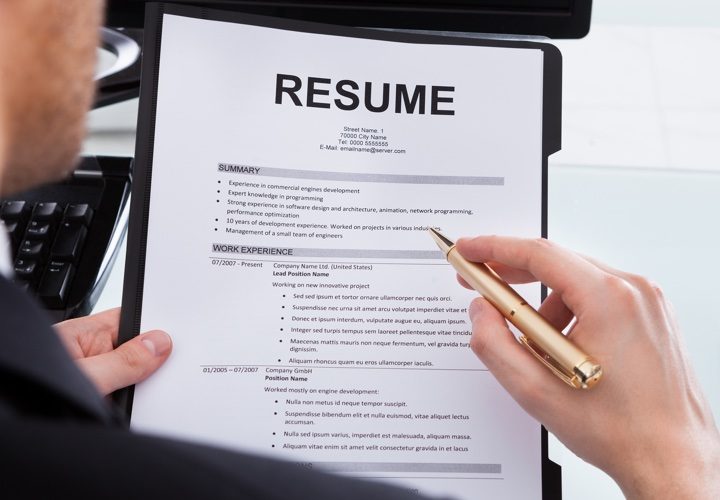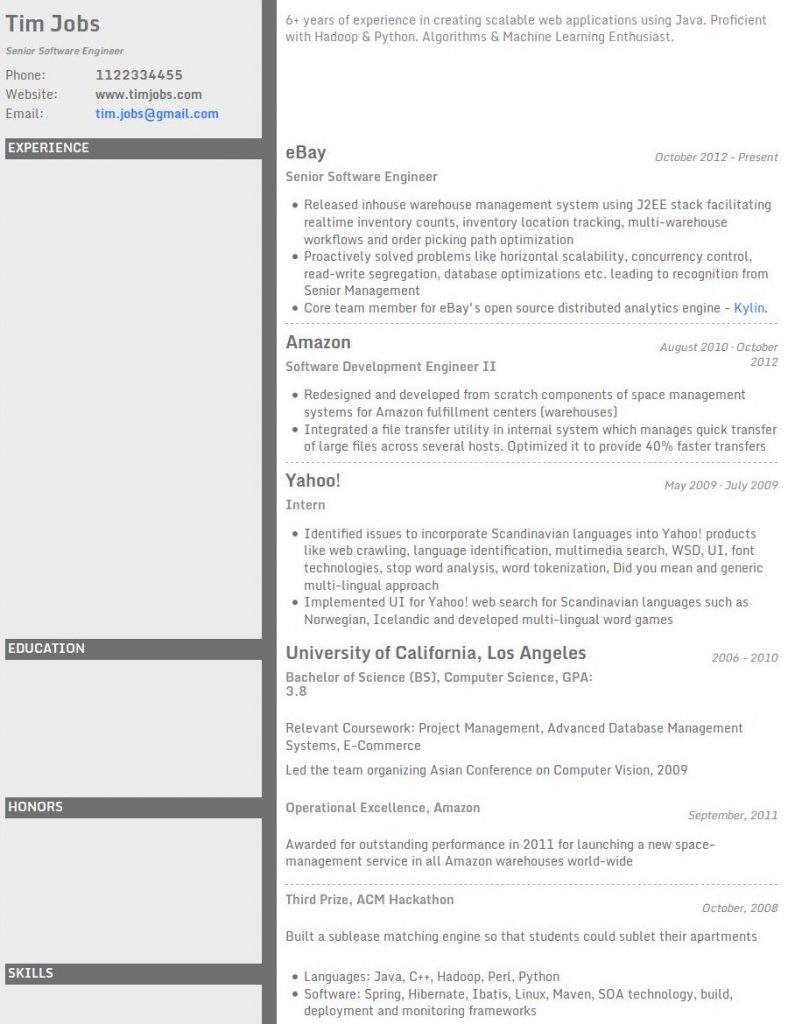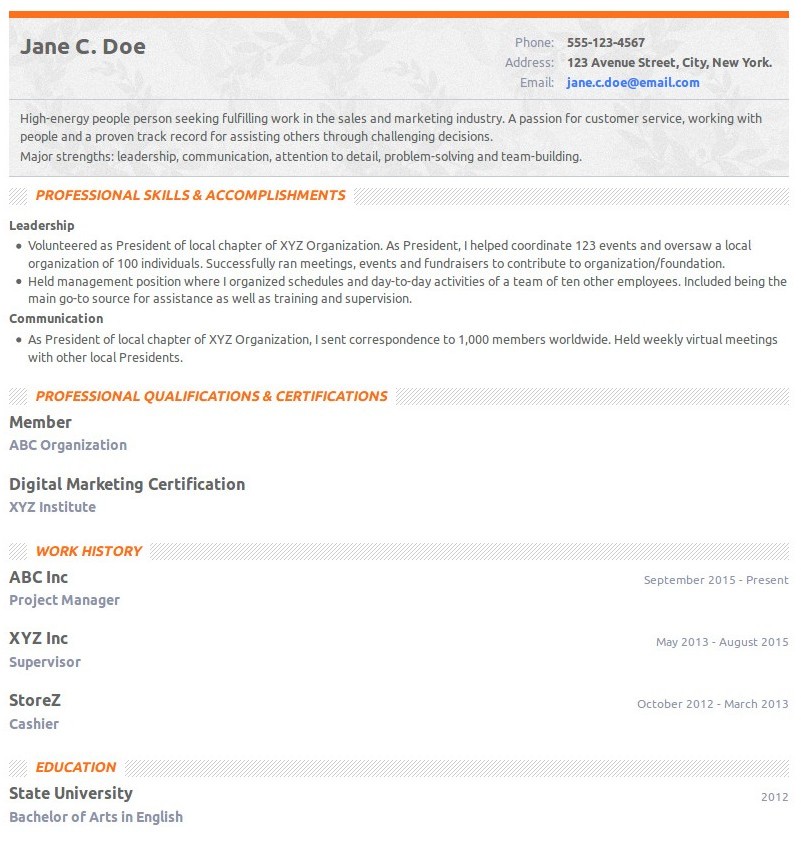
There are three basic types of popular resume formats: reverse chronological, functional, and hybrid.
Each plays a different role and highlights different but relevant skills and abilities. It’s up to you to decide which one will present you as the best candidate for the job you’re sending your resume. Choosing the right resume layout is crucial for helping you stand out.
Reverse chronological resume format
This is the most common resume format in the world. It highlights your key skills and experience by listing your most recent job first, then the rest of your experience and education fall into line behind.
Reverse chronological resumes can be used by anyone. The format is neat and organized, and adding and subtracting experience from the document is easy. However, this format might not be the best choice if you have gaps in your employment history, as it’s hard to hide periods when you were out of work, with the dates of employment being so prominent.
In addition, because this format is so universal, you’ll have to do something extra to stand out from other candidates applying for the same job. This is where Resumonk can elevate you above other job seekers. It’ll help you create an eye-catching and a well-formatted resume easily.
Here is an example of a reverse chronological resume created using the Concrete template on Resumonk –

Functional (skills-based) resume format
When creating a functional resume, ignore the rules of the reverse chronological format and place all your relevant skills and abilities at the top of the page. You should choose the key skills that best represent what you’ll need for the job you’re applying for, but if you want to highlight all your skills, that’s up to you.
These skills will usually fall under various categories, including supervisory skills, customer service skills, technical skills, and beyond — whatever best highlights your capabilities will be the headers you want to highlight.
Under those headers, give further details that provide evidence of your abilities. These can be listed as bullet points, making your resume easier for an employer to scan to find desirable skills and experience.
Even with a functional resume, you’ll still need to list your work experience and where you were previously employed. For gaps in your employment history, there are various ways to explain why you weren’t working — full-time student, full-time parent, traveling — and you’ll need to determine which one best fits your circumstance.
Remember that being too specific or vague could make you a less-than-ideal candidate for an employer.
One downside of using the functional resume format is that it isn’t conventional. Not all employers or resume robots can scan the document to see if you’re qualified for the position. Even though this format highlights your skills, it doesn’t show where and how you gained those skills, so it’s possible an employer may feel like you’re hiding something.
Using this format allows you to highlight your skills to show that you’re the best candidate for the job and allows employers to see those skills upfront. However, there are arguments that you should never use this format because various employers won’t even review them.
Here is an example of the functional resume format created using Resumonk’s Slim template:

Hybrid resume format
The hybrid format combines the reverse chronological and functional formats. This format benefits applicants with a lot of job history and wants to highlight their experience and expertise. When formatting your combination resume, it’s important to have a section that summarizes your qualifications and professional profile.
Your professional profile should briefly explain the skills you acquired through your previous work experience, while your qualification summary shows your accomplishments by applying those skills. The exact layout of how these sections look will be up to you, but keep in mind what the employer might be looking for and tailor your resume to what you think they would like to see.
The benefits of a hybrid resume are that it gives employers the traditional layout of a reverse chronological format with the bonus of more information highlighting your skills and experiences. It may even allow resume robots to easily scan the information in your resume and not reject it outright.
This combination resume, like the reverse chronological format, can work for a variety of different applicants in a variety of fields. However, since every field has nuances and expectations, find out which type of resume the employer prefers and tailor your resume to their specifications.
Deciding what type of resume format to use when applying for jobs will depend on what information you’re trying to highlight and the industry expectations you’re applying for. Getting past the initial scan is the most important first step, so ensure your resume gives you the advantage of reading more in-depth.
Key information and resume fonts
Ensure the format allows you space to include all relevant information. Some traditional resumes don’t always leave room for an email address or social media profile (if relevant to the role).
The font must also be noted – use a professional and recognized font that defaults on software such as Microsoft Word. Standard fonts for resumes are Raleway, Roboto, Montserrat, and Latin. You’ll also want to ensure your font isn’t too big or too small – usually between 10-12 points. Avoid making the font too small to squeeze in more text.
Remember, you don’t want your resume to stand out for the wrong reasons.
Don’t forget to make the most of your accompanying cover letter
Your cover letter is an equally important part of the application process, as it allows you to tell the hiring manager exactly how you’re the ideal candidate for the role and how your relevant skills and experience will fit with the job specifications. Make sure it’s formatted similarly to your resume so they don’t look like they don’t belong together. Also, avoid these common cover letter mistakes that can undermine its effectiveness.
By using resume builders, such as Resumonk, you can ensure that your resume and cover letter are formatted correctly and can be included in the same or separate files. Pay close attention to the employer’s preferred resume file type. Some may ask for Word documents, while others may prefer PDFs.
If this is your dream job, make sure you tell them. While your resume has to be succinct and professional, your cover letter allows you to demonstrate your enthusiasm, relevant experience, and any additional skills not referenced in your resume. You may also want to highlight some key achievements. Show your personality through your writing, and try to avoid bulleted lists.
Let them know your ideal career path if the role allows for learning and progression. Potential employers will be keen to hire those who want to climb the ladder and not leave the business quickly, so don’t forget to mention your career objectives.
Which format is best for you?
Unfortunately, there is no “perfect resume format,” as each has advantages depending on your background. The above three types of resumes apply to a wide range of jobs, and it depends on the role and your professional experience as to which will suit you better.
Regardless of the type of resume you need, Resumonk’s AI Resume Builder is here to assist. It offers AI Rewrites, AI Suggestions, and easy imports from LinkedIn or PDF/DOCX files, ensuring you get a resume that suits your requirements. Start your free trial today!



